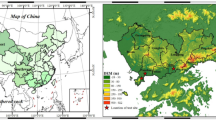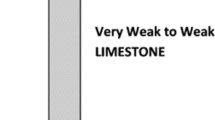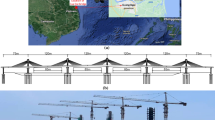Abstract
With advancements in drilling techniques and improved coring tools, deep foundations socketed into granitic rock have been widely used to support the heavy loads imposed by the high-rise buildings and bridges. To optimize the pile design, designers are often required to estimate the pile’s bearing capacity and subsequently validate the design parameters with pile load tests. Most of the time, the pile’s bearing capacity is calculated based on empirical models suggested by various researchers around the world. However, these equations may not be suitable, as the data used to derive them were based on the pile load tests carried out at various location, likely with different construction methodologies. This paper aims to develop an empirical model to estimate the pile shaft resistance in granitic rock based on uniaxial compressive strength (UCS) by using data from twelve pile load test results performed in Southeast Asia and three pile load test results carried out in East Asia. Thirteen of the piles tested by using bi-directional static load test (BDSLT) method and remaining tested by conventional top-down static load test method (SLT). Comparison between the actual test data and estimated capacity by using existing empirical models is also presented. This paper also further demonstrates the maximum displacement of pile shaft segment in rock upon reaching failure. For pile shaft resistance not reaching its ultimate value, a suitable method is applied to predict the ultimate shaft resistance values. End bearing capacity obtained from the pile tests is also presented herein as reference.
Access provided by Autonomous University of Puebla. Download conference paper PDF
Similar content being viewed by others
Keywords
- Pile bearing capacity
- Bi-directional static load test
- Granitic rock
- Uniaxial compressive strength
- Sustainable construction
1 Introduction
A deep foundation’s bearing capacity is mainly composed of two components, namely the shaft friction and the end bearing. The capacity of these two components is affected by several factors such as type of geological formation, construction practices, and pile material. For pile socketed into rock, factors such as interface roughness and uniaxial compressive strength (UCS) affect the pile bearing capacity.
Since 1970s, researchers have proposed empirical models to estimate the pile shaft resistance from the uniaxial compressive strength (\(q_u\)) of rock. These empirical models were established based on pile load test data conducted at various location around the world with different construction methodologies. Hence, it is important to have locally established empirical models for pile designers to estimate the rock shaft resistance with a good degree of confidence. Two types of rocks commonly encountered are igneous rocks and sedimentary rocks. The weathering classification is specified in Annex B of BS EN ISO 14689 Approach 2.
Pile shaft friction capacity develops through shearing of the bond between concrete and the rock or sliding friction or combination of both. Nam and Vipulanandan [1] conducted a study on the excavation roughness produced by different type of drilling tools. Seidel and Collingwood [2] also suggested socket roughness factor for prediction of rock socket shaft resistance. However, it is still not common to quantify the surface roughness as the instrument required for this work is not commercially available.
Most of the pile socketed into rock are constructed by using bored piling machine with its dedicated rock coring tools such as rock auger, core barrel with bullet teeth, and core barrel with roller bits. The bullet teeth or roller bit is fixed on the core barrel with certain angle typically between 1 to 7°, which is adjusted based on the hardness of the rock during trial bore on site. Another method of rock coring is by using reverse circulation drilling (RCD), where the drilled material is returned to the surface by flushing the medium inside the drill pipes. Case 13–15 in this study was constructed by using reverse circulation drilling method in East Asia. While the rest was constructed by using normal bored piling machine with core barrel-roller bit in Southeast Asia. Corel barrel with roller bit and rock core sample is shown in Fig. 1.
Polymer and bentonite are the two types of stabilizing fluids widely used for the pile excavation. As the bentonite filter cake reduced the shear strength of the pile soil interface over time, most of the piles constructed in recent years are utilizing polymer as the support fluid as it does not have a detrimental effect on the interface shear resistance [3]. Cleaning of the pile toe by de-sanding method or air-lift method is crucial step to ensure the performance of the pile especially the pile is heavily relied on end bearing, particularly for large diameter pile. Inspection of the toe cleanliness shall also be carried out, be it using conventional “sounding” or “dipping” method or quantitative method like sediment probe with depth encoder to record the sediment thickness prior to the concreting works.
2 Pile Test Method
Several test methods are available to test the pile socketed into granitic rock. Over 85% of the test pile results presented in this paper are tested with bi-directional static load test (BDSLT) or better known as “Osterberg Cell test (O-cell)” and two cases tested by conventional top-down static load test (SLT). One of the benefits of BDSLT is the sacrificial jack-like device can be pre-installed on the reinforcement cage and positioned near to the tip of the pile. As the jack expands, the end bearing provides reaction for the side shear and vice versa [4]. This method enables engineer to test the pile in full scale, loaded the pile in compression from the bottom until one of the two components (shaft friction or end bearing) reaches its ultimate capacity or until the maximum capacity of the jack installed in the pile. One of the benefits for pile tested with BDSLT method is the sacrificial jacks can be positioned within the rock socket or near to the toe of the excavation and test the rock socket capacity directly.
All the test piles are instrumented with telltale extensometers to measure the pile compression and pile displacement. Load distribution along the pile is estimated by attaching the vibrating wire strain gauges in pairs onto the reinforcement cages (Refer to Table 1 for the test pile summary).
3 Pile Test Result
3.1 Shaft Resistance Capacity
To establish a more reliable empirical relations, the ultimate value of the shaft friction shall be adopted. Test pile program shall be designed with additional test capacity to fully mobilize the pile. Figure 2 shows the top section of bi-directional static load test (BDSLT) fully mobilized. Maximum displacement of rock segment at failure for four cases in this study shown in the Fig. 3 below is approximately at 10–15 mm. Ayithi and Ryan [5] reported that average additional capacity beyond 10 mm displacement is less than 5% of the total capacity. This finding agrees well with data presented in this paper. Hence, shear displacement of 10 mm can be considered as upper bound for maximum shaft resistance.
Chin [6] suggested a hyperbolic curve fitting method (Fig. 4) to estimate the ultimate capacity of the shaft resistance based on actual test data. This method usually fits well with actual test data, where plot of the settlement versus ratio of settlement and resistance gives a linear relationship. Therefore, for the cases where pile displacement is less than 10 mm, ultimate value is obtained through Chin’s method.
Mobilized unit shaft resistance of moderately weathered granitic rock is presented in Table 2. The ultimate values for case 4 and case 10 are estimated based on Chin’s method with the maximum displacement limited to 10 mm.
3.2 End Bearing Capacity
The test pile unit end bearing capacity and its respective toe displacement show no clear correlation (see Table 3 and Fig. 5). As discussed by Fellenius [7], the end bearing resistance does not exhibit an ultimate value. Larger displacement could be due to the combination of the pile material strength and cleanliness of the pile base.
4 Review on Empirical Models for Shaft Resistance
Several empirical models were proposed to estimate the rock shaft resistance based on the uniaxial compressive strength (UCS) value. All these models were based on Eq. 1.
where fs is shaft resistance, qu is uniaxial compressive strength, Pa is atmospheric pressure (101.325 kPa), and B and n is the empirical factor derived from load test data. Summary of the selected empirical models is stipulated in Table 4.
Fifteen pile test data result was compared with the empirical models suggested by various researchers. It is clearly seen that the empirical models predicted shaft resistance is deviated away from the actual test data from test pile drilled with core barrel-roller bit. Three of the test pile result with its rock socket cored by using reverse circulation drilling method (RCD) is higher than empirical models suggested by Horvath and Zhang (see Fig. 6).
Based on the actual test data collected, an empirical model is proposed to suit the local soil condition as well as the construction practices (see Fig. 7). The assessment suggested the following:
Due to limited data for test pile with rock socket drilled by using reverse circulation drilling method, the three test piles data point are not included in the assessment. However, it shall be noted that the shaft resistance capacity is much higher than pile constructed with core barrel-roller bit (see Fig. 7).
5 Summary and Conclusions
A total of fifteen pile load test data was compiled, and a comparison was made against the empirical models. The data show that the existing available empirical models are not suitable for estimating the rock shaft friction in Southeast Asia region. Actual pile test data show that there is no significant increase in pile shaft resistance with the increase in UCS value. Hence, an empirical model is proposed specifically to estimate the pile shaft resistance in granitic rock socket and cored by core barrel with roller bits.
Bored pile socketed into rock can be constructed with different types of drilling tools and stabilizing fluids. The empirical equation shall be used with caution, and the adopted design parameters for construction shall be proven by full-scale pile load test.
References
Nam, M.S., Vipulanandan, C.: Roughness and unit side resistance of drilled shafts socketed in clay shale and limestone. J. Geotech. Environ. Eng. 1272–1279 (2008)
Seidel, J.P., Collingwood, B.: A new socket roughness factor for prediction of rock socket shaft resistance. Can. Geotech. J. 38(1), 138–153 (2001)
Lam, C., Jefferis, S.A., Suckling, T.P., Troughton, V.M.: Effects of polymer and bentonite support fluids on the performance of bored piles. Soils Found. 55(6), 1487–1500 (2015)
Schmertmann, J.H., Hayes, J.A.: The Osterberg cell and bored pile testing-a symbiosis. In: Proceedings of Third International Geotechnical Engineering Conference, pp. 139–166. Cairo University, Cairo Egypt (1997)
Ayithi, A., Ryan, W.G.: Unit side shear in rock-socketed bored piles. In: 10th International Conference on Stress Wave Theory and Testing Methods for Deep Foundations, pp. 97–127 (2019)
Chin, F.K.: Estimation of the ultimate load of piles from tests not carried to failure. In: Proceedings of the 2nd Southeast Asian Conference on Soil Engineering, pp. 81–92. University of Singapore, Singapore (1970)
Fellenius, B.H.: Capacity versus deformation analysis for design of footings and piled foundations. Geotech. Eng. J. 41(2), 70–77 (2011)
Rosenberge, P., Journeaux, N.L.: Friction and end bearing tests on bedrock for high capacity socket design. Can. Geotech. J. 12(3), 324–333 (1976)
Horvath, R.G., Kenny, T.C.: Shaft Resistance of Rock Socketed Drilled Piers, Symposium on Deep Foundations, pp. 182–214. ASCE, New York (1979)
Rowe, P.K., Armitage, H.H.: A design method for drilled piers in weak rock. Can. Geotech. J. 24(1), 126–142 (1987)
Zhang, L., Einstein H.H.: Closure to “End bearing capacity of drilled shafts in rock”. Geotech. Eng. J. 125(12), 1109–1110 (1999)
Kulhaway, F.H., Prakoso, W.A., Akbas, S.O.: Evaluation of Capacity of Rock Foundation Sockets, pp. 1–8. American Rock Mechanics Association, Alexandria, VA (2015)
Lam, C., Jefferis, S.A., Suckling, T.P.: Construction techniques for bored piling in sand using polymer fluids. Proc. Inst. Civil Eng. Geotech. Eng. 167(GE6), 565–573 (2014)
Zhang, L., Einstein, H.H.: End bearing capacity of drilled shaft in rock. Geotech. Eng. J. 124(7), 574–584 (1998)
Leung, C.F.: Case studies of rock-socketed piles. Geotech. Eng. J. 27(1), 51–67 (1996)
Rezazadeh, S., Eslami, A.: Empirical methods for determining shaft bearing capacity of semi-deep foundations socketed in rocks. J. Rock Mech. Geotech. Eng. 1140–1151 (2017)
Author information
Authors and Affiliations
Corresponding author
Editor information
Editors and Affiliations
Rights and permissions
Copyright information
© 2024 The Author(s), under exclusive license to Springer Nature Singapore Pte Ltd.
About this paper
Cite this paper
Oh, Y.P., Ismail, M.A.M. (2024). Bearing Capacity of Deep Foundation Socketed into Granitic Rock. In: Sabtu, N. (eds) Proceedings of AWAM International Conference on Civil Engineering 2022 - Volume 3. AICCE 2022. Lecture Notes in Civil Engineering, vol 386. Springer, Singapore. https://doi.org/10.1007/978-981-99-6026-2_5
Download citation
DOI: https://doi.org/10.1007/978-981-99-6026-2_5
Published:
Publisher Name: Springer, Singapore
Print ISBN: 978-981-99-6025-5
Online ISBN: 978-981-99-6026-2
eBook Packages: EngineeringEngineering (R0)











